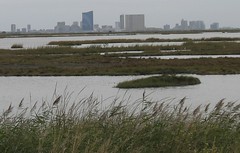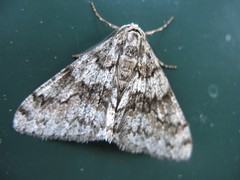The practice of birding is currently undergoing major changes in response to technological changes. These changes include both the introduction of new types of technology as well as new modes of using existing technologies. These changes can be disorienting; while some birders are happy to adopt any new gadget that comes along, others see no reason to change their proven ways of doing things. Somewhere between the "social media will save the world" and "social media is a faddish waste of time" schools lies the truth, and it's impossible for us to totally grasp that truth, caught up in the historical moment of change as we are. What we can do is look back at a previous world-changing technological shift in the practice of birding: the shift from collecting birds with guns to looking at birds with binoculars. The tried-and-true ways we may now want to keep were once themselves novel and suspect to the old school.
There are several good histories of the time period covered by this change (Barrow [1998] is more academic, while Weidensaul [2007] is aimed at a general audience), but the way I'm going to tackle this topic is by looking at how this technological shift altered the language of bird descriptions found in books intended to guide bird students. These identification guides set forth the basic criteria by which a bird student could determine the identity of a bird. Although the technology by which observations were made changed (shotgun vs. binoculars), the technology that helped bird students understand what they were observing (the printed book) did not. What did change in these guides was the graphic presentation of the information and the language used to describe the identification criteria for birds.
Enough generalities, let's start by comparing a couple of descriptions of the same species, from Shriner (1896) and Peterson (1980). Shriner goes first:
"Length, twelve and a half inches; extent, twenty inches; general color above, blue slate; feathers of the head long and pointed, forming a conspicuous crest, bluish slate, centered with black; the inner tail feathers have an irregular black stripe down the middle, the rest are black, with slaty blue edges, all are more or less spotted with white; long wing feathers, black, with the basal portion white and a few white spots on some of the outer webs; color of under surface of the body, white, with a broad slaty blue band across the breast, while the sides of the body are slaty with white bars; the white of the throat extends around on the back of the neck, forming a more or less complete collar, and there is a white spot in front of the eye and another just below it; some individuals have white dots on the upper surface of the wings, and in certain plumages the slaty breast band is suffused with rusty; the bill is two inches long, strong, sharp-pointed, and black, excepting near the base of the lower part of the tip, where it is of a horn color; the wings are marked with small specks of white; legs, extremely short, of a dirty yellow color, above the knee bare of feathers for half an inch; the two exterior toes are united together for nearly their whole length; claws, stout and black. The female has a reddish brown band across the under side of the body below the slaty breast band, while the sides of the body are also of this color." Paragraphs on nesting habits (including description of the eggs), distribution, and diet ("exclusively fish") follow.
Now here's Peterson:
"Hovering on rapidly beating wings in readiness for the plunge, or flying with uneven wingbeats (as if changing gear), rattling as it goes, the Kingfisher is easily recognized. Perched, it is big-headed and big-billed, larger than a Robin, blue-gray above, with a ragged bushy crest and a broad gray breastband. The female has an additional rusty breastband." Single sentences on Voice, Range, a reference to the eastern range map, and Habitat follow.
There are obvious differences in length between these two descriptions. Shriner's description includes more details than Peterson's, first giving measurements, then plumage colors in detail, followed by structural details such as the bill and feet. Nowhere is behavior mentioned (there is no reference to "hovering" in his discussion). This description is clearly intended for a bird student with the bird in hand and enough leisure to note fine points such as the black centers to the head feathers and white spots on the outer webs of the flight feathers. The description in its list-like structure portrays the bird as a collection of parts that are given equal weight.
Peterson, by contrast, writes of the bird in motion, describing its feeding and flight behavior. The only color notes are the general "blue-gray above," "broad gray breastband" and description of the female's rusty breastband. On one hand, there's no need for Peterson to describe the bird in further color detail since a color plate of both male and female kingfishers is on the page facing the text (Shriner has a black and white photo of a taxidermist's mount of several kingfishers). Even so, the emphasis is on what the bird is likely to be doing when a bird student finds it rather than what it looks like. Rather than listing the structural features as independent items, as Shriner does, Peterson unites them in the succinct phrase, "big-headed and big-billed," pulling the big picture out of the details. The details that Peterson uses are chosen carefully, with the most prominent ones highlighted and others discarded from the description entirely.
Two different descriptions of the same species are, of course, a very small study sample, but I suspect a larger study would arrive at similar findings.
Bird books from the transitional period between shotguns and bins (think the 1920s-1930s) tend to try to cover both bases. Forbush (1925-1929) included both descriptions and field marks. Bagg and Eliot (1937) listed details of sight observations that today we would pass off without discussion, but that still did not satisfy people like Ludlow Griscom (Davis 1994). Stone (1964) expressed concern about sight records and their reliability, but also had this to say:
"No descriptions of the birds are presented as everyone interested in bird study today possesses one or more manuals for identification. There are, however, many comments on the appearance of birds in the field, of the deceptive effect of light and shadow upon coloration and the relative value of field characters. Even these are perhaps unnecessary in view of the appearance, after most of the 'studies' had been written, of Roger Peterson's admirable 'Field Guide to the Birds,' but so intimately are they associated with other parts of the text that it seemed best to allow them to stand."
We will return to description as a basic part of bird documentation later in this series, but this is its birthplace: when specimens were not always available but records of noteworthy observations needed to be kept.
In the next post in this series, we will return the present and look at the falling cost of bird photography.
Bagg, Aaron Clark, & Samuel Atkins Eliot, Jr. 1937. Birds of the Connecticut Valley in Massachusetts. Hampshire Bookshop, Northampton, MA.
Barrow, Mark, Jr. 1998. A Passion for Birds: American Ornithology After Audubon. Princeton University Press, Princeton, NJ.
Davis, William E., Jr. 1994. Dean of the Birdwatchers: A Biography of Ludow Griscom. Smithsonian Institution Press, Washington, DC.
Forbush, Edward Howe. 1925-1929. Birds of Massachusetts and Other New England States. Commonwealth of Massachusetts, Norwood, MA.
Peterson, Roger Tory. 1980. A Field Guide to the Birds. Houghton Mifflin, Boston, MA.
Shriner, Charles A. 1896. The Birds of New Jersey. Fish & Game Commission of the State of New Jersey, [Patterson, NJ].
Weidensaul, Scott. 2007. Of a Feather: A Brief History of American Birding. Harcourt, Orlando, FL.
Previously in this series:




